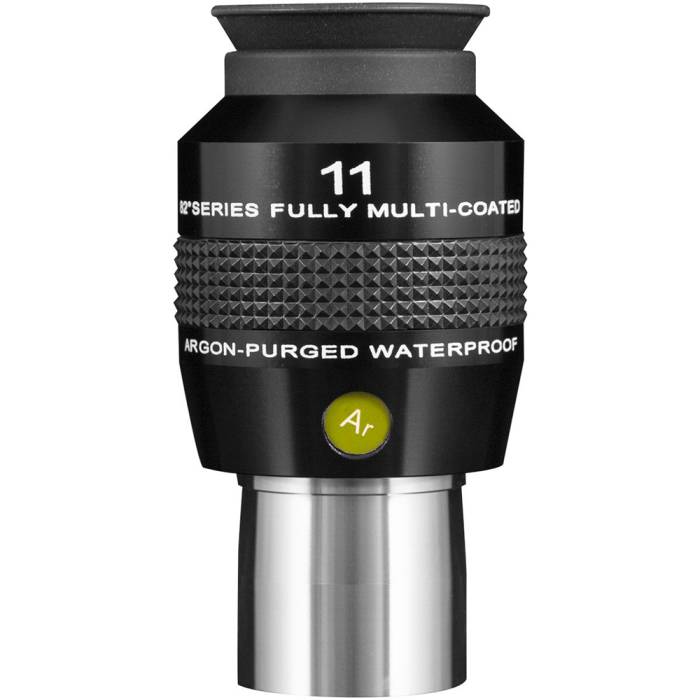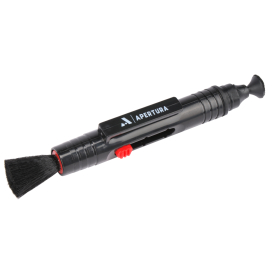Explore Scientific 11 mm - 82° Argon Purged Waterproof 1.25" Eyepiece
The Explore Scientific 82° Series 11mm Waterproof Eyepiece
Blending comfort, quality, and value, Explore Scientific offers their 82° Waterproof Eyepiece series, a perfect choice for those seeking a high quality immersive viewing experience! This wide field of view paired with the 11 mm focal length gives way to stunning sights of the Hercules Star Cluster, the Crab Nebula, Saturn’s Rings, and a host of other deep space objects and planets. Thanks to the expert craftsmanship from Explore Scientific, you can expect high contrast, high resolution views, and superior flat field correction across the expansive scope of vision. Suitable for both planetary viewing and deep space observing, the Explore Scientific 82° Series 11mm Waterproof Eyepiece is wonderful for any astronomy enthusiast!
In addition to a quality optical design, this premium eyepiece is engineered for comfort, including a long eye relieving of 15.6 mm. Your eye is relaxed, enabling prolonged observing sessions without eye strain, and offering comfortable viewing for eyeglass wearers. The waterproof, argon-purged body prevents internal fogging for unwavering crisp views for years to come, making this a reliable eyepiece to have at hand! A blackened interior and multicoated optics further enhance performance, ensuring striking views without glare. As the perfect tool for vast, expansive sights and designed with user-experience in mind, it’s easy to see why the Explore Scientific 82° Series 11mm Waterproof Eyepiece deserves a place within your eyepiece kit!
The Perfect Solution for Panoramic Stargazing
This Explore Scientific eyepiece offers stunning, wide field views and is fine-tuned for your comfort. Read on as we take a deeper dive into the aspects of this must have optical accessory!
82° of Excellence
With an aim to deliver an immersive, relaxing observing experience, the Explore Scientific 82° eyepiece series provides next-level nights under the stars. The precision engineered optics give way to stark sights of the cosmos, while the meticulous body design promotes comfort with a long eye relief and adjustable eyecups. Thanks to careful craftsmanship, it’s much easier to observe the night sky for prolonged periods of time, with details emerging that weren’t available at first glance. This wide field of view also further assists with revealing beautiful structure via averted vision. This is where looking slightly to the side of an object as opposed to directly at it helps us view things more clearly, as our peripheral vision is strongest in the dark. With the ingenuity from Explore Scientific, you’re well equipped for beautiful, captivating sights that are sure to impress!
Premier Build Quality
Each Explore Scientific eyepiece within the 82° series is crafted with the utmost care—including precision machined metal lens barrels for outstanding optical performance well into the future. This rugged casing upholds ideal alignment of the internal lenses, while the waterproof, argon-purged design prevents moisture damage even in cold, humid environments. The internal lenses are a combination of low dispersion and high refractive index optical glasses equipped with durable enhanced multilayer deposition (EMD) coatings, giving way to top-tier image quality. All interior surfaces of the eyepiece barrel along with the edges of the lenses themselves are matte black for a significant reduction in internal reflections. Not only will you be able to enjoy stark, high contrast views, but you’ll also benefit from reduced eye strain in the absence of distracting reflections. Furthering comfort, the twistable eyecup can be easily raised or lowered, offering a viewing experience tailored for you.
11 mm of Focal Length
Finding the ideal combination of eyepiece focal length and telescope focal length will help you take full advantage of your telescope’s light gathering power. This ratio, i.e. your system’s magnification, gives insight into what celestial objects can be viewed, as well as how clear the image will be based on your local seeing conditions. Under good seeing conditions, it’s best to capitalize on this still air by utilizing higher magnifications, while lower magnifications help you make the most out of poor seeing. The formula for magnification is as follows: Telescope Focal Length ÷ Eyepiece Focal Length. This Explore Scientific eyepiece has a focal length of 11 mm. When paired with a standard 1200 mm Newtonian, you can expect a magnification of 109x, an upper-medium power magnification wonderful for observing globular star clusters, planetary nebulae, the bright cloud structure near the nucleus of comets, as well as the planets. For a more in-depth look at this topic, be sure to check out our Telescope Eyepiece Guide found within our Astronomy Hub.
Understanding Exit Pupil
As the beam of light exiting your eyepiece, the exit pupil determines how bright the image through your eyepiece will be. We measure the exit pupil by its diameter in millimeters, with the bigger the diameter, the brighter the image. In general, deep sky objects become visible with an exit pupil of 2 mm or greater, with fainter and fainter targets becoming more and more visible as the exit pupil increases. Small exit pupils (<2 mm), on the other hand, prove to be useful for viewing compact, bright objects, such as the planets or our Moon. Calculating the exit pupil of your eyepiece/telescope combination is super easy: Exit Pupil = Telescope Aperture (mm) ÷ Magnification, or Exit Pupil = Eyepiece Focal Length ÷ Telescope Focal Ratio. This Explore Scientific 82° Series Waterproof Eyepiece has a focal length of 11 mm. When paired with a standard f/6 telescope, the resulting exit pupil will be 1.8 mm, making this eyepiece a great choice for observing the wonders of our solar system, bright nebulae, and star clusters!
Astronomy Hub: Your one-stop-shop for Astronomy Knowledge!
Our Gear Experts have compiled a wealth of information to help you get the most out of your telescope! Below you’ll find links to articles, videos and "how-to" guides. Just one more reason that our Astronomy Hub is a one-stop-shop for all your astronomy and astrophotography needs!
| The Best Telescopes of the Year |
| Best Telescopes For Urban Stargazing |
| What's in the Sky This Month? |









